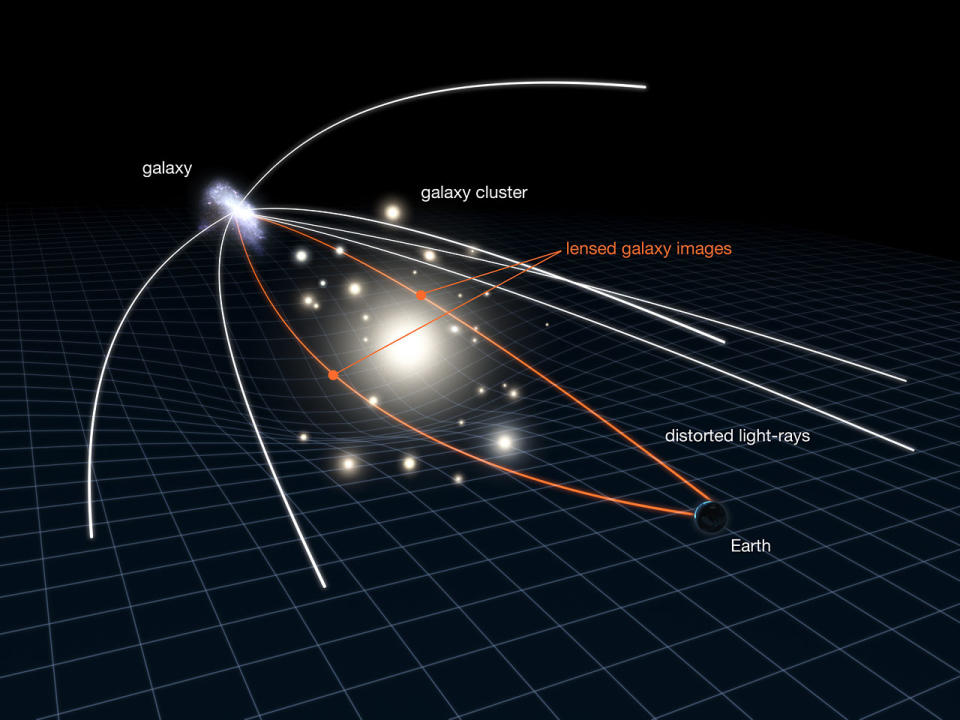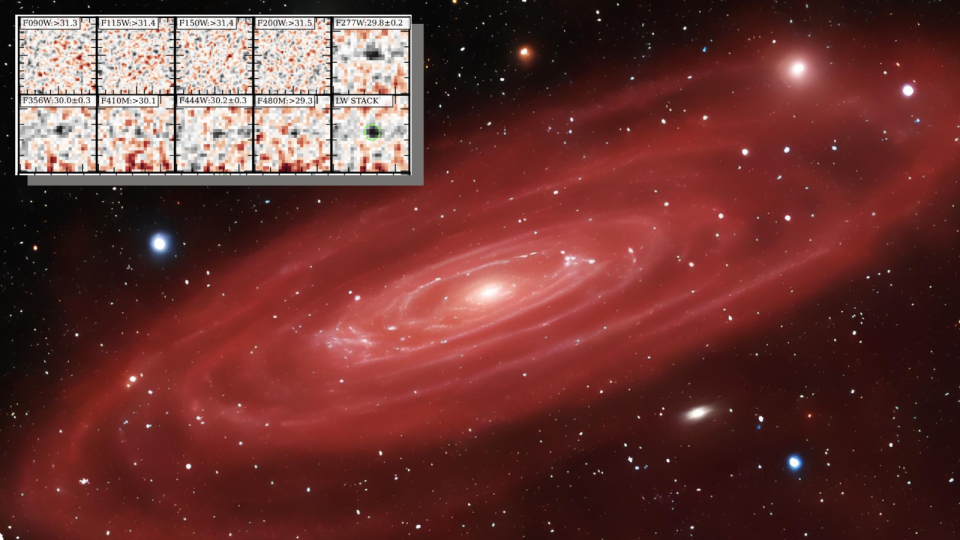When you buy through links on our articles, Future and its syndication partners may earn a commission.

An illustration of a highly redshifted galaxy as it may appear if the JWST could zoom in on it. (Inset) Five candidate galaxies identified by the JWST as part of the GLIMPSE project which could turn out to be the earliest and most distant galaxies ever seen. | Credit: Robert Lea (created with Canva)/ Kokorev et al 2024
The James Webb Space Telescope has potentially smashed one of its own records again —- if scientists are correct, this trailblazing spacecraft may have glimpsed the earliest galaxies in the universe.
The five galaxy candidates are located so far away that the furthest is seen as it was just 200 million years after the Big Bang. Thus, the light from these galaxies has been traveling to Earth for around 13.6 billion years. Because of the expansion of the universe, these galaxies should now lie a staggering 34 billion light-years away. However, to be clear, none of this is yet confirmed.
Advertisement
Advertisement
Prior to this discovery, made as part of the James Webb Space Telescope’s (JWST’s) Galactic Legacy Infrared Midplane Survey Extraordinaire (GLIMPSE) project, the most distant galaxy observed by the powerful space telescope was JADES-GS-z14-0. That one was seen as it was when the universe was around 280 million years old.
These new galaxies will be officially named when they are confirmed, but will likely all have the prefix “GLIMPSE” in reference to the survey that uncovered them. These could potentially be the earliest possible galaxies to exist, per our current models of the universe’s evolution.
“It remains quite challenging to estimate the exact age of these galaxies and to determine when they formed, but we are certainly approaching the first generation of galaxies because we are left with only around 150 million years to form these galaxies,” discovery team member Hakim Atek, a researcher at the Paris Institute of Astrophysics, told Space.com. “With so little time available, there are not many ways you can form galaxies.
“In the end, these observations will put tight constraints on the physical processes that are allowed in our models of the universe.”
Seeing red with help from Einstein
Early galaxies, such as these five new candidates, are described as “high-redshift” or “high z” galaxies. This is because the expansion of the universe causes the wavelengths of light such galaxies emit to be stretched as the wavelengths travel to us. As longer (more stretched out) wavelengths are found at the “red end” of the electromagnetic spectrum, this process is described as redshift.
Advertisement
Advertisement
The longer light has taken to reach us, the more extreme the red shift that it undergoes. The amount of redshift a galaxy has experienced is denoted as “z” followed by an equals sign, then a unitless number.
According to Las Cumbres Observatory, a redshift of z = 0.10 corresponds to light that has been traveling to Earth for 1.3 billion years and is now 1.3 billion light-years away. A redshift of z =1 corresponds to light that has traveled 7.7 billion years and, as the result of the expansion of the universe, is now 10.1 billion light years away. A redshift of 10 corresponds to an emitting body about 26.6 billion light-years away from us with light that has traveled for 13.2 billion years.

Ten black squares in two layers of five containing red and blue dots
The JWST is now routinely discovering galaxies with redshifts between z = 10 and z = 14. As mentioned above, the earliest confirmed galaxy, JADES-GS-z14-0, has a redshift of z = 14.2. These five new potential galaxies, however, have redshifts of z = 16 to z = 18.
Team leader Vasily Kokorev of the University of Texas explained to Space.com that finding these galaxies continues the trend of the JWST discovering more high-luminosity galaxies densely clustered in the early universe at high redshifts or “high z” than was expected before the $10 billion telescope began sending data back to Earth in the summer of 2022.
Advertisement
Advertisement
More in Science
“Finding so many galaxies at high-z in the same field means their number densities are higher than we expected,” Kokorev said. “The objects we found also consistently fit into the new paradigm of overabundance of bright galaxies at high-z. These are also potentially some of the youngest galaxies we have seen so far.”

The galaxy cluster Abell S1063, as seen by the NASA/ESA Hubble Space Telescope during the Frontier Fields program. The huge mass of the cluster — containing both normal matter and dark matter — acts as a cosmic magnifying glass, deforming the views of objects behind it. Astronomers have used this gravitational lensing effect to calculate the distribution of dark matter in galaxy clusters. Another way of doing this is to study the intracluster light (visible in blue), which follows the distribution of dark matter.
The discovery of these five candidate galaxies has been possible because GLIMPSE observations are the deepest ever obtained in the sky. The results, the first from the GLIMPSE project, also got an assist from the Abell S1063 galaxy cluster, located around 4 billion light-years away. That cluster was able to help thanks to a phenomenon first predicted by Albert Einstein in 1915 called “gravitational lensing.”
In 1915, Einstein posited his theory of gravity, which is known as “general relativity.” This theory suggests that gravity arises from objects with mass curving the fabric of space and time (united as a 4-dimensional entity called “spacetime”). The more mass an object has, the greater the “dent” in spacetime it creates, and thus the larger its gravitational influence.
When light from an object passes an extreme curvature of spacetime caused by something truly massive on its way to our Earth-based detectors, like a cluster of galaxies, its path is also curved. The closer to this lensing body light passes, the more extreme its curvature. That means, by taking different paths around a gravitational lens, the five GLIMPSE galaxies can arrive at different times to a telescope like the JWST that sits in our corner of the cosmos.
Advertisement
Advertisement
This effect is called gravitational lensing because it can magnify the appearance of the background object. The JWST has been using this phenomenon to great effect to detect distant early galaxies that would be too faint to be seen without gravitational lensing. In this case, the cluster Abell S1063 was the gravitational lens used by the GLIMPSE team.

gravitational lensing infographic
Even with the most powerful space telescope ever constructed and with a powerful cosmic phenomenon, these galaxies were still too faint to see in enough detail to identify their characteristics.
“To really dig deep into their nature would require spectra. At the moment, we know that these objects are quite faint intrinsically, especially compared to the most recent JWST discoveries at high-z,” Kokorev said. “This faintness, combined with how many we discover in such a small volume, might have some interesting implications about the emergence of the first galaxies in the universe.”
For Atek, one of the most fascinating aspects of the discovery is that these galaxies will evolve to become like the unusually bright galaxies that the JWST was glimpsing when the cosmos was between 300 and 400 million years old.
Advertisement
Advertisement
As for the possibility of the JWST discovering even earlier galaxies than these five candidates, Atek isn’t confident it will be possible.
“The JWST has the potential to discover even earlier galaxies, but this will depend on their number, density, and luminosity, which are tied to how early galaxy formation unfolded,” Atek continued. “We are entering completely uncharted territory and cannot know for sure what we will find. Many of these sources are expected to be so faint that spectroscopic confirmation, even with JWST, will be extremely challenging or unfeasible.”
Related Stories:
— James Webb Space Telescope spots 1st ‘Einstein zig-zag’ — here’s why scientists are thrilled
Advertisement
Advertisement
— Surprise! The universe’s expansion rate may vary from place to place
— Astronomers reevaluate the age of the universe
Even if there were earlier galaxies in the infant universe to be uncovered, it is possible that even an instrument as powerful as the JWST — using a tool as magnificent as gravitational lensing — may not be able to spot them.
Kokorev pointed out that detecting earlier and fainter galaxies could take 450 hours of observation time with the JWST (the GLIMPSE project had just 150 hours), and the researcher thinks this is not very likely to happen any time soon.
Advertisement
Advertisement
“So, in theory, yes, one can still find even earlier and distant galaxies; however, these would be even fainter and smaller, making them extremely hard to detect,” Kokorev. “The GLIMPSE program has already really pushed the telescope to its limit.”
Despite this, there are undoubtedly still more exciting results to be delivered by GLIMPSE.
“This is the first paper of many more to come, so keep an eye out for more GLIMPSE science,” Kokorev concluded. “We are very excited about the data and all the exciting science it will provide!”
The team’s research is published in preprint form of the paper repository arXiv.
EMEA Tribune is not involved in this news article, it is taken from our partners and or from the News Agencies. Copyright and Credit go to the News Agencies, email news@emeatribune.com Follow our WhatsApp verified Channel



